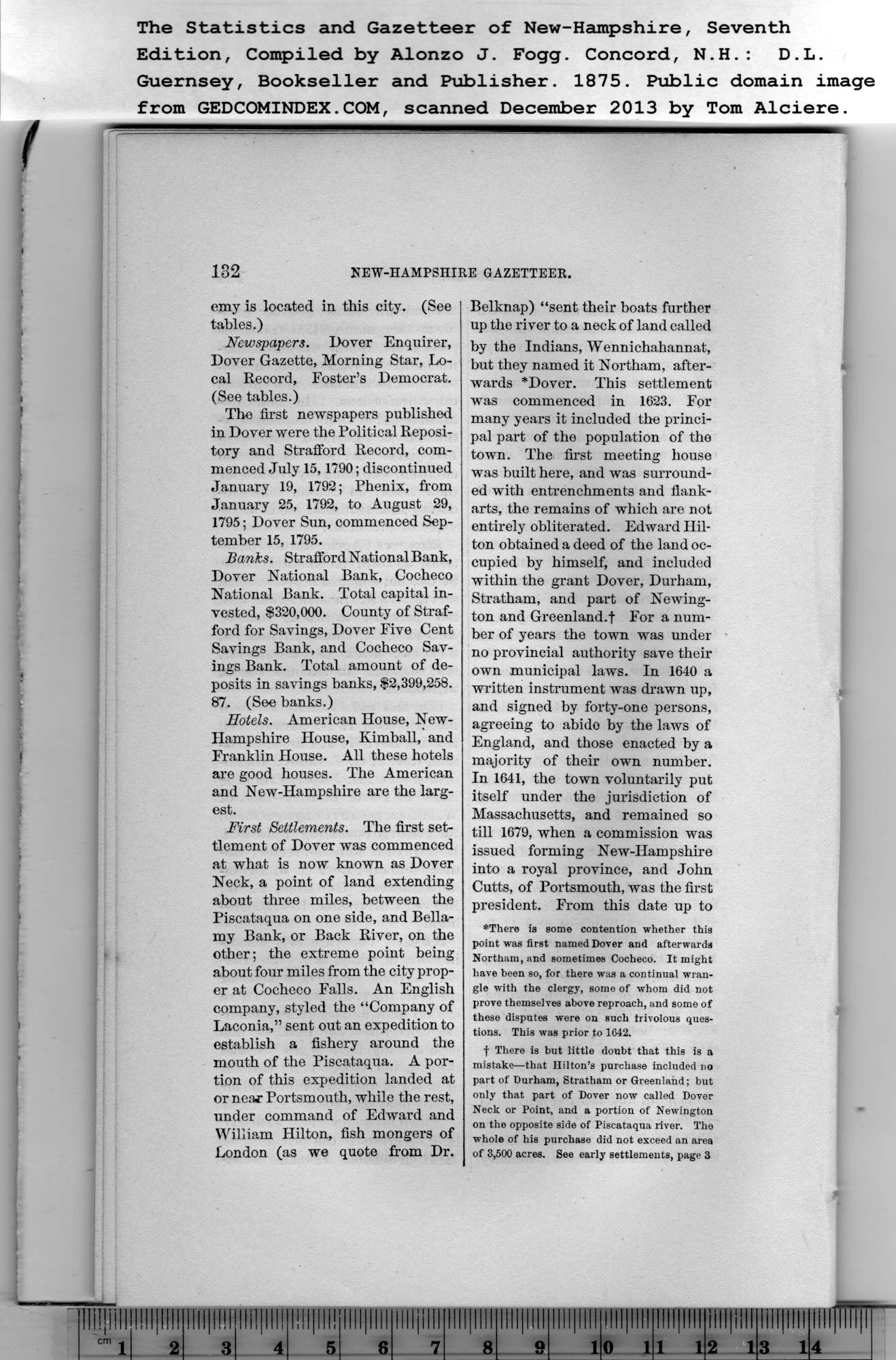|
132
The Statistics and Gazetteer of New-Hampshire, Seventh
Edition, Compiled by Alonzo J. Fogg. Concord, N.H.: D.L.
emy is located in this city. (See
tables.)
Newspapers. Dover Enquirer,
Dover Gazette, Morning Star, Lo-
cal Record, Foster’s Democrat.
(See tables.)
The first newspapers published
in Dover were the Political Reposi-
tory and Strafford Record, com-
menced July 15,1790; discontinued
January 19, 1792; Phenix, from
January 25, 1792, to August 29,
1795; Dover Sun, commenced Sep-
tember 15, 1795.
Banks. Strafford National Bank,
Dover National Bank, Cocheco
National Bank. Total capital in-
vested, $320,000. County of Straf-
ford for Savings, Dover Five Cent
Savings Bank, and Cocheco Sav-
ings Bank. Total amount of de-
posits in savings banks, $2,399,258.
87. (See banks.)
Hotels. American House, New-
Hampshire House, Kimball, and
Franklin House. All these hotels
are good houses. The American
and New-Hampshire are the larg-
est.
First Settlements. The first set-
tlement of Dover was commenced
at what is now known as Dover
Neck, a point of land extending
about three miles, between the
Piscataqua on one side, and Bella-
my Bank, or Back River, on the
other; the extreme point being
about four miles from the city prop-
er at Cocheco Falls. An English
company, styled the “Company of
Laconia,” sent out an expedition to
establish a fishery around the
mouth of the Piscataqua. A por-
tion of this expedition landed at
or near Portsmouth, while the rest,
under command of Edward and
William Hilton, fish mongers of
London (as we quote from Dr. |
Belknap) “sent their boats further
up the river to a neck of land called
by the Indians, Wennichahannat,
but they named it Northam, after-
wards *Dover. This settlement
was commenced in 1623. For
many years it included the princi-
pal part of the population of the
town. The first meeting house
was built here, and was surround-
ed with entrenchments and flank-
arts, the remains of which are not
entirely obliterated. Edward Hil-
ton obtained a deed of the land oc-
cupied by himself, and included
within the grant Dover, Durham,
Stratham, and part of Newing-
ton and Greenland.! For a num-
ber of years the town was under
no provincial authority save their
own municipal laws. In 1640 a
written instrument was drawn up,
and signed by forty-one persons,
agreeing to abide by the laws of
England, and those enacted by a
majority of their own number.
In 1641, the town voluntarily put
itself under the jurisdiction of
Massachusetts, and remained so
till 1679, when a commission was
issued forming New-Hampshire
into a royal province, and John
Cutts, of Portsmouth, was the first
president. From this date up to
♦There is some contention whether this
point was first named Dover and afterwards
Northam, and sometimes Cocheco. It might
have been so, for there was a continual wran-
gle with the clergy, some of whom did not
prove themselves above reproach, and some of
these disputes were on such frivolous ques-
tions. This was prior to 1642.
f There is but little doubt that this is a
mistake—that Hilton’s purchase included 110
part of Durham, Stratham or Greenland; but
only that part of Dover now called Dover
Neck or Point, and a portion of Newington
on the opposite side of Piscataqua river. The
whole of his purchase did not exceed an area
of 3,500 acres. See early settlements, page 3 |
